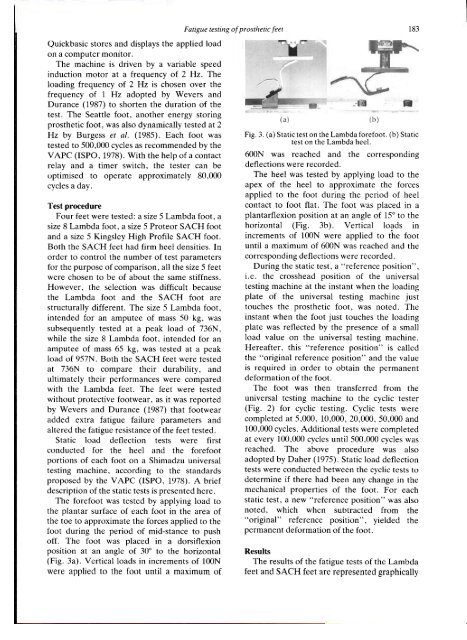Fatigue testing of energy storing prosthetic feet
Fatigue testing of energy storing prosthetic feet
Fatigue testing of energy storing prosthetic feet
Create successful ePaper yourself
Turn your PDF publications into a flip-book with our unique Google optimized e-Paper software.
Quickbasic stores and displays the applied load<br />
on a computer monitor.<br />
The machine is driven by a variable speed<br />
induction motor at a frequency <strong>of</strong> 2 Hz. The<br />
loading frequency <strong>of</strong> 2 Hz is chosen over the<br />
frequency <strong>of</strong> 1 Hz adopted by Wevers and<br />
Durance (1987) to shorten the duration <strong>of</strong> the<br />
test. The Seattle foot, another <strong>energy</strong> <strong>storing</strong><br />
<strong>prosthetic</strong> foot, was also dynamically tested at 2<br />
Hz by Burgess et al. (1985). Each foot was<br />
tested to 500,000 cycles as recommended by the<br />
VAPC (ISPO, 1978). With the help <strong>of</strong> a contact<br />
relay and a timer switch, the tester can be<br />
optimised to operate approximately 80,000<br />
cycles a day.<br />
Test procedure<br />
Four <strong>feet</strong> were tested: a size 5 Lambda foot, a<br />
size 8 Lambda foot, a size 5 Proteor SACH foot<br />
and a size 5 Kingsley High Pr<strong>of</strong>ile SACH foot.<br />
Both the SACH <strong>feet</strong> had firm heel densities. In<br />
order to control the number <strong>of</strong> test parameters<br />
for the purpose <strong>of</strong> comparison, all the size 5 <strong>feet</strong><br />
were chosen to be <strong>of</strong> about the same stiffness.<br />
However, the selection was difficult because<br />
the Lambda foot and the SACH foot are<br />
structurally different. The size 5 Lambda foot,<br />
intended for an amputee <strong>of</strong> mass 50 kg, was<br />
subsequently tested at a peak load <strong>of</strong> 736N,<br />
while the size 8 Lambda foot, intended for an<br />
amputee <strong>of</strong> mass 65 kg, was tested at a peak<br />
load <strong>of</strong> 957N. Both the SACH <strong>feet</strong> were tested<br />
at 736N to compare their durability, and<br />
ultimately their performances were compared<br />
with the Lambda <strong>feet</strong>. The <strong>feet</strong> were tested<br />
without protective footwear, as it was reported<br />
by Wevers and Durance (1987) that footwear<br />
added extra fatigue failure parameters and<br />
altered the fatigue resistance <strong>of</strong> the <strong>feet</strong> tested.<br />
Static load deflection tests were first<br />
conducted for the heel and the forefoot<br />
portions <strong>of</strong> each foot on a Shimadzu universal<br />
<strong>testing</strong> machine, according to the standards<br />
proposed by the VAPC (ISPO, 1978). A brief<br />
description <strong>of</strong> the static tests is presented here.<br />
The forefoot was tested by applying load to<br />
the plantar surface <strong>of</strong> each foot in the area <strong>of</strong><br />
the toe to approximate the forces applied to the<br />
foot during the period <strong>of</strong> mid-stance to push<br />
<strong>of</strong>f. The foot was placed in a dorsiflexion<br />
position at an angle <strong>of</strong> 30° to the horizontal<br />
(Fig. 3a). Vertical loads in increments <strong>of</strong> 100N<br />
were applied to the foot until a maximum <strong>of</strong><br />
<strong>Fatigue</strong> <strong>testing</strong> <strong>of</strong> <strong>prosthetic</strong> <strong>feet</strong> 183<br />
Fig. 3. (a) Static test on the Lambda forefoot, (b) Static<br />
test on the Lambda heel.<br />
600N was reached and the corresponding<br />
deflections were recorded.<br />
The heel was tested by applying load to the<br />
apex <strong>of</strong> the heel to approximate the forces<br />
applied to the foot during the period <strong>of</strong> heel<br />
contact to foot flat. The foot was placed in a<br />
plantarflexion position at an angle <strong>of</strong> 15° to the<br />
horizontal (Fig. 3b). Vertical loads in<br />
increments <strong>of</strong> 100N were applied to the foot<br />
until a maximum <strong>of</strong> 600N was reached and the<br />
corresponding deflections were recorded.<br />
During the static test, a "reference position",<br />
i.e. the crosshead position <strong>of</strong> the universal<br />
<strong>testing</strong> machine at the instant when the loading<br />
plate <strong>of</strong> the universal <strong>testing</strong> machine just<br />
touches the <strong>prosthetic</strong> foot, was noted. The<br />
instant when the foot just touches the loading<br />
plate was reflected by the presence <strong>of</strong> a small<br />
load value on the universal <strong>testing</strong> machine.<br />
Hereafter, this "reference position" is called<br />
the "original reference position" and the value<br />
is required in order to obtain the permanent<br />
deformation <strong>of</strong> the foot.<br />
The foot was then transferred from the<br />
universal <strong>testing</strong> machine to the cyclic tester<br />
(Fig. 2) for cyclic <strong>testing</strong>. Cyclic tests were<br />
completed at 5,000, 10,000, 20,000, 50,000 and<br />
100,000 cycles. Additional tests were completed<br />
at every 100,000 cycles until 500,000 cycles was<br />
reached. The above procedure was also<br />
adopted by Daher (1975). Static load deflection<br />
tests were conducted between the cyclic tests to<br />
determine if there had been any change in the<br />
mechanical properties <strong>of</strong> the foot. For each<br />
static test, a new "reference position" was also<br />
noted, which when subtracted from the<br />
"original" reference position", yielded the<br />
permanent deformation <strong>of</strong> the foot.<br />
Results<br />
The results <strong>of</strong> the fatigue tests <strong>of</strong> the Lambda<br />
<strong>feet</strong> and SACH <strong>feet</strong> are represented graphically
















